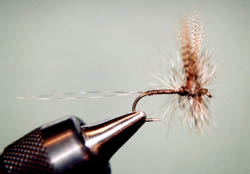Fly Angler's OnLine "Fly of the Week #20"
Nearenuf (Dry Fly)
January 12th, 1998 |

Photo Copyright ©1998 James Birkholm.
Thanks for use permission.
|
 |
 |
Hook: |
Any dry fly hook: 12, 14, 16, 18. |
Thread: |
6/0 dark thread. |
Wing: |
Lemon wood duck, split and upright. |
Tail: |
Two stripped grizzly hackles, flared
and tied extra long. |
Body: |
Quill from peacock eye. |
Hackle:
| Mixed dark ginger and grizzly. |
|
This fly is a great one for
the beginner. It will give practice to handling some feathers and quills that one
would not usually use in this manner. The hackle and quill need to be stripped.
A soft eraser will work fine for removing the barbels from both the feathers
and the quill. Just lay them flat and rub; off comes the material. The quill of
the peacock should be soaked, so as not to crack. Some use water, others
use exotic mixtures of glycerin and water. A figure eight between the tails
and between the wings will help to keep them in position. JC
|
|
Tying Instructions:
- Attach thread near rear of hook.
- Fasten two stripped hackles, flaring each.
- Tie in stripped quill.
- Add a spot of head cement to the base of the tails and quill.
- Wind quill evenly forward to point for the wings and secure.
- Tie in wings pointing forward; tilt upright with
thread wraps in front. Separate with figure eights.
- Tie in hackles behind wings, leave thread in front of wings.
- Wind hackles separately to front and tie off.
- Whip finish and cement head.
Tying Tip
-
Try tying this fly in both dark and light versions. If the fish don't rise to
one - try the other. JC
Worked For Me
-
I came across the Nearenuf early in my fly fishing life. It
was just what I needed. At the time I was fishing the
AuSable near Grayling, Michigan. My collection of books was
just taking off and the fly would serve me well until I had
figured out the stuff in the books.
-
My casting was coming together and some knowledge of
insects had started to sink in as well. The fly tying had also
made some progress. I was a perfect candidate for the
Nearenuf. It can be tied by a beginner. It will not look
perfect. I guess it doesn't have to. It took trout the way I
tied it.
-
The current was fairly swift on the river and the
temptation to fish a dry downstream was strong. I must
admit to more than a time or two, of doing just that. I
would fish slowly from the center of the stream, casting
directly to the edge and throw a small upstream mend into
the drift. This would allow the fly to ride somewhat properly
for a few feet before it would sink into, or under the surface.
-
Not the 'proper' way to fish, I know, but it did bring up
some nice brooks and natives. Some were hooked dry,
others emerging (sinking), and some downright wet. Most
were lost due to hooking them from the wrong direction
and the trout having the advantage of being downstream at
the start of the encounter. (Which is why you don't fish dry
flies downstream.)
-
I think what stands out most about the fly is that it gave
me confidence that I had at least a fly that was pretty close
to what ever was out there. I could concentrate on the fish,
where to cast, reading the water, and catching trout.
Eventually, I gave more time to 'upstream and dry'
improving my success. I raised more trout and the hooking
and landing ratio doubled.
-
I am confident that no matter where you are in your fly
fishing career this fly will serve to bring up trout, whether
on the classic eastern creeks, the blue-ribbons of the
mid-west, or the fabled waters of the Rockies. At least you
will have the right size, almost the right color, and a fly that
is "Nearenuf' to fool most trout. ~ JC
|